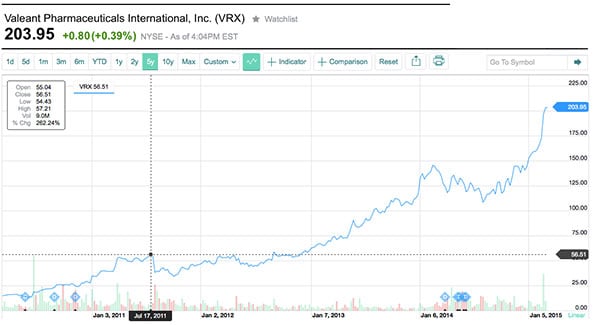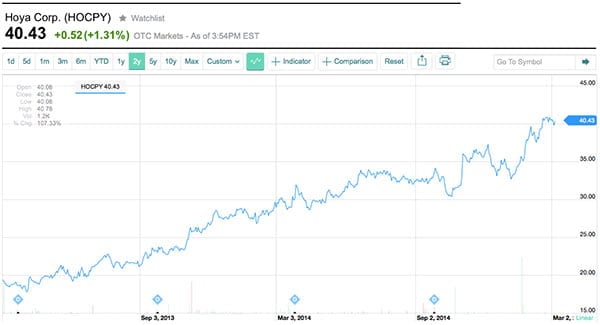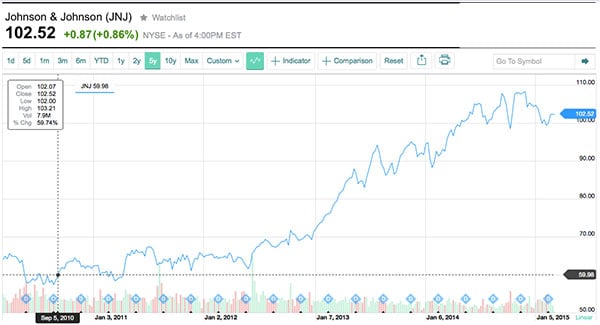Myopia Drives Profit.
Your myopia is a condition that fuels an industry with hundreds of billions of dollars in annual revenue. Ophthalmologists, optometrists, universities, government taxes, they all are part of the “food chain” of this for-profit enterprise.
This isn’t meant to be an indictment of mainstream eyesight healthcare. You merely should consider the big picture of what motivates the people who tell you that your eyesight can’t be maintained preventatively, or rehabilitated. The current focus is on treating a symptom, not to remove the root cause.
Let’s look at how significantly myopia has been adding to the bottom line of the industry:
Zeiss Meditech
Carl Zeiss Meditec AG is a multinational medical technology company. It manufactures tools for eye examinations. Annual revenues of 906 million dollars. Stock chart:
Valeant
Valeant is the maker of Bausch & Lomb contact lenses. Annual revenue 3.3 billion dollars, prior to being bought by Valeant for 8.7 billion dollars. Five year stock chart:
Hoya
Hoya Corporation is a Japanese company manufacturing optical products, contact lenses and eyeglass lenses. Annual revenue, 4.4 billion dollars. Stock chart:
Essilor
Essilor International S.A. is a French company that produces ophthalmic lenses along with ophthalmic optical equipment. Annual revenue, 4.99 billion dollars. Five year stock chart:
Johnson & Johnson
J&J is the maker of Acuvue, one of the largest contact lens brands. Current annual revenue is at 63.75 billion dollars. Here is their 5 year stock performance:
There are hundreds and hundreds more of these. There are thousands of universities, and millions of optic shops and practitioners making money on the back of your myopia. Look how dramatically higher their revenues are compared to even five years ago. Now consider how much myopia has been increasing worldwide.
What would happen to all of them, if we were to explore myopia prevention and rehabilitation?
But let’s not speculate on motives. Let’s look at facts.
Are These Companies Ethical?
“Johnson & Johnson, the world’s biggest health-care products maker, and Bausch & Lomb Inc. were among firms fined a combined 19.6 million yuan ($3 million) for price fixing in the country’s contact lens and eye-glass market.”
Profit is obviously at the center of any publicly traded company. Can rehabilitation and prevention fit into that mandate? It could, though it doesn’t appear to be the case quite yet.
Are These Companies Looking To Slow The Myopia Epidemic?
Essilor International SA, the world’s biggest maker of eyeglass lenses, may spend as much as 1 billion euros ($1.2 billion) next year on acquisitions globally as it expands into emerging markets.
“This is the biggest market for myopic people, half of the myopic people in the world are in China,” Sagnieres said.
In China, Essilor will buy and partner with small retailers to increase sales beyond the cities of Beijing, Shanghai and Guangzhou, Sagnieres said on the sidelines of an advisory board meeting at the China Europe International Business School. The company, which was fined earlier this year for violating an anti-monopoly law in the country, invested in a sunglasses seller based in southern China last year.
Finding ways to reduce the dependency on a product is obviously not a first priority to the business. It is our own individual responsibility to look at the merits of the product, and to what extent we want to rely on products or advice of any business.
Do These Companies Have Influence On Medical Education?
Johnson & Johnson 2014 Annual Shareholder Meeting: proxy2014_JNJ Note the number of university administrators listed.
And here too, the list gets long, if you start to look.
“Essilor has an ongoing commitment to ophthalmic education, students and the ophthalmic profession. We are proud to offer many quality educational programs every year for both students and professionals.”
The lens makers directly fund optometry education, and run universities teaching future doctors how to manage myopia. This of course creates a risk for focus on the product sales, and doesn’t leave a whole lot of room for research on methods to reduce individual dependence on said product.
All this being said, companies tend not to be inherently good or evil. They are simply responding to (and in part creating) consumer demand. It is our own duty to understand whether this is what we ultimately want and will benefit from.





